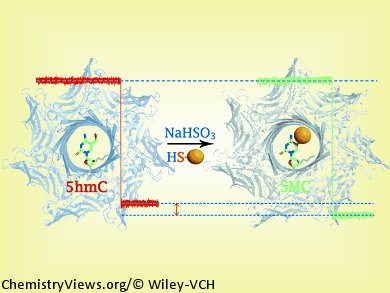Methylation of DNA Bases
Changes in the bases that make up DNA act as markers, telling a cell which genes it should read and which it shouldn’t. In the journal Angewandte Chemie, a British team has now introduced a new method that makes it possible to enrich the rare gene segments that contain the modified base hydroxymethylcytosine and to identify individual hydroxymethylcytosine molecules in DNA. Such modifications are associated with autoimmune diseases and cancer.
The bases adenine, guanine, cytosine, and thymine make up the genetic code. Every cell of the body contains an identical set of complete genetic material. However, the various tissues in the body are very different from each other. This is because the cells have the ability to transcribe only a specific selection of genes into proteins, leaving other genes unused. Epigenetic factors such as “markers” on the DNA control this process. The base cytosine can be equipped with different side groups, such as a methyl or hydroxymethyl group. Dense methylation of regulatory gene segments switches off the corresponding genes. During development of the embryo, methylation patterns initiate cell differentiation. Changes in the methylation patterns are associated with autoimmune diseases and cancer. Hydroxymethylcytosine patterns also seem to play a role in the differentiation of embryonic stem cells as well as in gene expression in cells of the central nervous system.
Specific Detection of Epigenetic Bases
Sequencing techniques that can be used to specifically detect epigenetic bases are thus very important. To date, the identification of hydroxymethylcytosine has required complex, expensive, or error-prone processes. A team led by Hagan Bayley at the University of Oxford University, UK, has now developed a chemical modification that allows for the differentiation of hydroxymethylcytosine and methylcytosine through sequencing in nanopores.
Developed by Oxford Nanopore, a company formed by Hagan Bayley in 2005, the nanopore method is a highly promising alternative to the sequencing of individual DNA molecules without an amplification step. Fed by an enzyme, a single strand of DNA threads through a membrane-embedded protein pore. Depending on which of the bases is in the narrowest part of the pore at a given time, there is a characteristic change in the flow of current through the pore.
A chemical reaction between hydroxymethylcytosine, bisulfite, and a cysteine-containing peptide that leaves the other bases—including methylcytosine—unchanged, greatly improves the resolution as the various bases result in differences in current.
Importantly, it is possible to attach a fluorescent marker to the modified site, or a molecular “eye” that can be used to attach the rare hydroxymethylcytosine-containing DNA fragments to “hooks” that allow the fragments to be enriched over unmodified fragments, enabling rapid sequence analysis.
- Single-Molecule Detection of 5-Hydroxymethylcytosine in DNA through Chemical Modification and Nanopore Analysis,
Wen-Wu Li, Lingzhi Gong, Hagan Bayley,
Angew. Chem. Int. Ed. 2013.
DOI: 10.1002/anie.201300413




